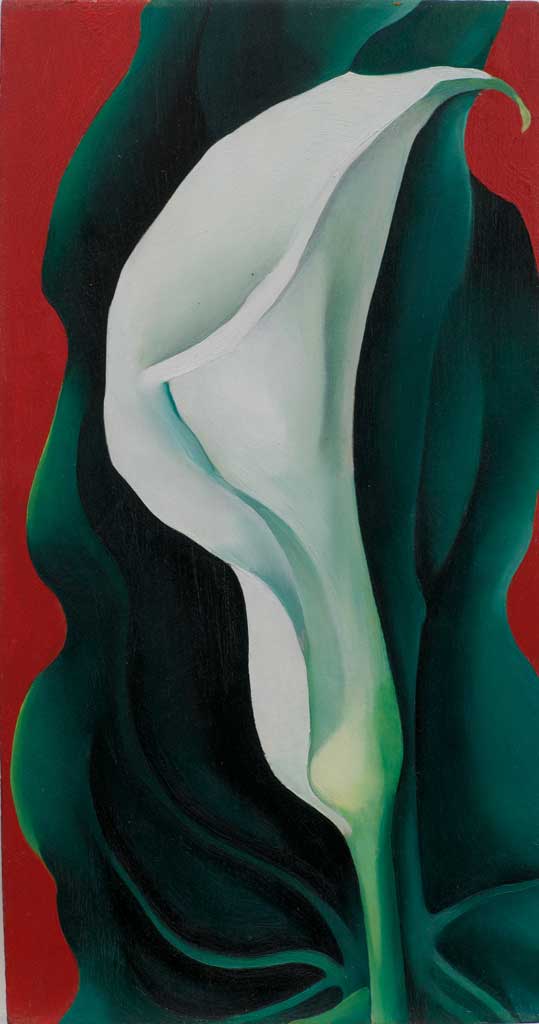Great Works: Single Lily with Red, 1928 (30.5cm x 15.9cm), Georgia O'Keeffe
Whitney Museum of American Art, New York

The point about flowers as they were so often painted by some of the great still-life painters of, say, the 17th century in Holland, is that for the most part each flower was one amongst many. No flower was a self-preening individualist. No flower said: 'look at me in all my separately seductive gorgeousness, passing stranger'. Each separate bloom belonged to a great cascading of colour, a marvellous tonal agglomeration, a huge, peacockishly fan-like shapeliness.
What is more, it is the fact of the pleasing generality of those scenes, which may well have included a brace or two of dead birds (paintings are odour-free), that not only engages us, but also made paintings of this kind so saleable to those art-thirsty Dutch burghers in their heady state of prideful, newly won independence. Each flower was one amongst many, and each one was relatively – yes, relatively speaking – small. Each one belonged to a kind of chorus-line of flowers. There was no star turn. What is more, most of those kinds of paintings were wholly morally unexceptionable. They could hang anywhere. There was nothing to cause offence. Children were not corrupted. Flowers were nothing but flowers: beautiful, and extremely pricey when rare indeed. In short, they were a matchless export, painted or not.
Now look at this painting by Georgia O'Keeffe, painted in the middle of the 1920s. The rules have all changed. O'Keeffe believes in flowers as individuals – and individualists. She wants them to strut their stuff. She wants them to be more than they often seem to be when offered, awkwardly, by a man (by way of apology for a long, hard night) in their crinkly-papered bunches. Just look at the comeliness, the singular shapeliness of this lily. It seems to want to stretch so tall in order to remind us of the full extent of its beauty. You could call it balletic in the way that it yearns almost to fling itself backwards against that luxurious-looking ground of rich green leaf, set against an even richer red. Those background colours enhance the sense of the flower's own singular presence amongst us. They make it seem even more precious than ever. In fact, this particular variety of lily was not especially rare or precious amongst blooms – sometimes it was even despised.
Here it is a shockingly forthright presence, looming particularly large, as large as it would be if an insect were to be ogling it. And, yes, that is exactly our perspective as we look at it, peering just over the brim of the cup of its calyx, though not very far. We are more bees than human at this moment. Its size almost overshadows us. It looms over us, almost menacingly. We feel almost stiflingly close up to it – and this sense of our proximity is enhanced by the fact that we do not see the flower and its partially enclosing leaf in their entirety. We have zoomed in too close to see everything, and by choosing to represent it in this way, O'Keeffe has also, simultaneously, slightly reduced the degree of realism. She has nudged the flower, though authentic enough thanks to its sheeny, almost tackily waxy presence, which is so lovingly and painstakingly rendered, in the direction of a more generalised emblem of shapeliness. She has also emphasised its anthropomorphic qualities. We could even argue that she has nudged us into looking at it as a partial representation of the luxuriously clothed female body, presented to us partially enveloped in that cloak-like green ground. Let us not push this analogy too far, though. O'Keeffe responded furiously when her critics grossly sexualised her flower paintings. Let us stop at that.
ABOUT THE ARTIST
Georgia O'Keeffe (1887-1986) grew up in the American MidWest and spent much of her life in the wilds of New Mexico. Her painting helped to redefine the American painterly idiom during the 1920s in reaction against the dominant aesthetic of Europe. Her painting has been loosely described as "magic realism", which means that she invested real things with a kind of heightened aura of singularity which at times drifted in the direction of Surrealism. Many of her greatest paintings were of flowers and New York City. The first category she painted with a ferocious and almost brutal panache. She was married to the celebrated photographer Alfred Stieglitz.
Subscribe to Independent Premium to bookmark this article
Want to bookmark your favourite articles and stories to read or reference later? Start your Independent Premium subscription today.

Join our commenting forum
Join thought-provoking conversations, follow other Independent readers and see their replies